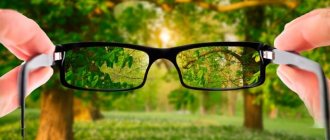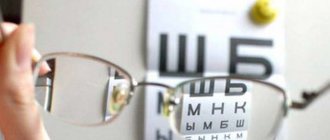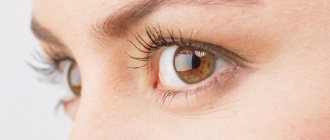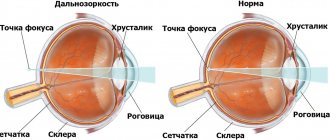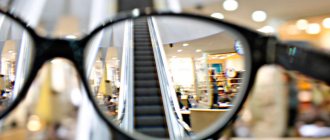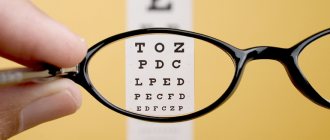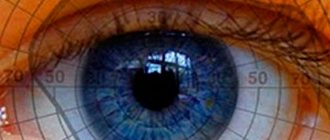Our eye is often compared to a camera. The role of the lens in it is played by the cornea and lens: they transmit and refract rays of light entering the eye, and the role of photographic film is assigned to the retina: on which, thanks to photoreceptors, the image appears. It is then converted into nerve impulses and transmitted through the optic nerve, like wires, to the brain. The image will be clear if the cornea and lens refract the rays so that the focus (the point of connection of the rays) is on the retina. This is why healthy people see well into the distance.
Refraction of the eyes with healthy vision
Human visual ability is due to the special structure of the eye apparatus, which captures light rays and focuses them in the central region of the retina. It is here that the transformation of light into special nerve impulses occurs, which are transmitted by the optic nerves to the brain, where a full-fledged three-dimensional image is synthesized. The main parameters of the visual organs that influence the refractive function include the refractive power and the length of the axis of the eyeballs; they are responsible for the areas of focusing of light beams. Thus, with healthy vision, the focus falls on the center of the retina and is called emmetropia.
A correctly functioning refractive system allows a person to clearly see objects at different distances - close and distant, respectively, reducing or increasing the refractive power of the lens (a biconvex natural lens). The described process in ophthalmology is called accommodation.
When the refractive function is impaired, the focus shifts, and the resulting new location causes myopia or farsightedness.
Causes of myopia
Factors that provoke the development of myopia are the following:
- elongated eyeball;
- a strong degree of refraction of the light flux by the lens or cornea;
- weakness of the accommodative muscle (it is responsible for holding the lens);
- long close work (long stay in front of a computer or other device, reading in a weak light source or in transport).
The threat from myopia is that the organs of vision are constantly under strain, which often results in headaches. And in the dark it is more difficult to navigate on the street or drive a vehicle. But the most serious threat is retinal detachment.
Refractive error of the eye: myopia
Myopia, or, as they say in scientific language, myopia, is a pathology of the visual system, characterized by focusing the image in front of the retina, and not on it, as with healthy vision. The disease involves changes in the shape of the eyeball - an increase in its anteroposterior axis or a decrease in focal length due to the reduced refractive power of the cornea.
In the presence of myopia, a person sees objects well up close, but gets a blurry picture of objects distant from him.
By its nature, myopia can be congenital, that is, hereditary, or acquired. As a rule, the second type of disease is observed with severe stress on the visual system, which consists of poor lighting during work, prolonged daily use of a computer, gadgets or TV, when reading, writing, etc.
If visual impairment is not detected in a timely manner, it will progress.
According to the severity, myopia is:
- Weak - up to -3 diopters;
- Medium - up to -3 to -6 diopters;
- High - from -6 diopters.
Are 2 pathologies possible at the same time?
Conditions in which plus and minus vision are present simultaneously are quite common.
In the presence of myopia and hyperopia in combination, the following pathologies are diagnosed:
- Astigmatism. With the disease, there is a shift in the refraction of light rays and focusing at several points simultaneously. In pathology, both 1 eye and 2 are affected at the same time. Astigmatism occurs due to irregularities in the shape of the lens or curvature of the cornea.
- Age-related changes in the visual apparatus. Patients with myopia are susceptible to presbyopia. Pathology develops at 40 or 45 years of age. The development of pathology is provoked by deterioration in the elasticity of the lens or weakening of the ciliary muscles. If a patient has mild myopia, he receives compensation in clarity of vision due to the development of age-related destructive processes.
Regardless of the reasons that provoked the development of simultaneous pathologies, an individual selection of an optical means for restoring picture clarity is necessary.
Symptoms of myopia
Of course, the most important symptom of the development of myopia is a noticeable decrease in visual acuity when viewing objects at distant distances; all other symptoms will indicate the progression of the disease.
These include:
- Dizziness and headaches are caused by severe overload of the visual apparatus and circulatory disorders of the ciliary muscle and other eye structures.
- Pain and burning sensations in the eyes most often occur when working with objects at a close distance from a person and are associated with anomalies of accommodation. The burning sensation may cause cramping.
- Excessive tearing - also occurs with heavy visual stress or looking at bright objects.
- Photophobia is explained by the fact that a person with myopia has a dilated pupil due to damaged ciliary muscle.
- Increased size of the palpebral fissure is associated with a strong increase in the eyeball, which protrudes forward, spreading the eyelids. The symptom can be visually noticeable with a high degree of myopia.
Myopia
With this disease, a person has difficulty seeing into the distance. The disease can be congenital or acquired. Congenital myopia occurs as a result of postpartum trauma or hereditary pathology.
Acquired myopia most often occurs for the following reasons:
- high visual load;
- immune system disorders;
- avitaminosis;
- traumatic brain injuries;
- increased blood and intraocular pressure;
- infectious diseases.
Refractive error of the eye: farsightedness
Farsightedness is a visual impairment in which, under resting conditions of accommodation, light rays are projected behind the retina rather than on it. However, when accommodation functions, the focus can be moved to the center of the retina. Despite the fact that many experts claim that with farsightedness the patient does not see objects close up well, this is not entirely true.
In reality, a person has blurred vision at any distance, but as long as the reserve of accommodative ability allows, it is compensated (except in cases of severe disease).
Hyperopia implies a reduced length of the anteroposterior axis of the eyeball, which is observed as the norm in children under 7-8 years of age during the formation of the visual apparatus. In other cases, this is a pathology that occurs against the background of injuries or proliferation of connective tissues. In addition, the cause of farsightedness can be hardening of the lens, loss of its elasticity, etc. This phenomenon is characteristic of patients who have reached the age of 40-45 years, it is called presbyopia. In this case, the ciliary muscle does not contract and is almost always at rest.
Hypermetropia is classified according to severity:
- Weak - up to +2 diopters;
- Medium - from +2 to +5 diopters;
- High - over +5 diopters.
Myopia, farsightedness, astigmatism
The human eye is a complex optical system. To ensure clear vision, it is necessary that light rays reflected from surrounding objects, passing and refracting through the main optical elements of the eye (cornea (1) and lens (2)), are focused on the retina (3). Then the refractive power of the eye (refraction) is called commensurate or emmetropic. To distinguish objects located at different distances from the eye, the work of the accommodative apparatus, consisting of the ciliary (ciliary) muscle (4), ligaments of Zinn (5) and lens (2), is necessary. Tension or relaxation of this muscle is reflected in the tension of the ligaments that are connected to the lens. Due to its elasticity, the lens can change the curvature of the surface, and therefore change the refractive power of the eye, which allows light rays to be focused on the retina. The greatest strain of accommodation is required when viewing closely located objects.
The unit of measurement of the refractive power of the optical system is diopter (dopter). The main refractive errors (ametropia) include myopia (myopia), farsightedness (hyperopia), astigmatism and “age-related” farsightedness (presbyopia). According to the severity of ametropia, they are divided into: - weak - up to 3.0 diopters; - medium - 3.25 - 6.0 diopters; - high - more than 6.0 diopters.
Myopia or myopia is the most common vision defect in which light rays reflected from distant objects and entering the eye are focused not on the retina, but in front of it. Distance visual acuity is low and directly depends on the degree of myopia. Diagram. The path of light rays in the eye (myopia) There are refractive and axial myopia. The first is characterized by a normal size of the optical axis (within 24 mm in an adult) and too strong refractive power of the cornea and/or lens. Axial myopia is more common: the eyeball is elongated in length (more than 24 mm) with normal refractive power of the eye. Myopia is divided into congenital and acquired, as well as stationary (non-progressive) and progressive. Considering the high prevalence of myopia, the likelihood of its occurrence at any age, as well as the possibility of progression and the appearance of complications (in particular, degenerative changes in the fundus, ruptures and detachment of the retina, opacities of the vitreous body, etc.), leading to decreased vision up to blindness, everyone should be attentive and careful about their health. At the same time, it is important to understand the causes of development and signs of myopia, which will help you consult a doctor in a timely manner and receive the necessary correction and/or treatment.
The main causes of myopia are:
visual work at close range with weakened accommodative ability of the eye,
weakening of the strength properties of the outer shell of the eye (sclera),
· hereditary predisposition: if parents or close relatives have myopia, then there is a high probability that the child will also have vision problems.
The negative impact of visual hygiene disorders is known (poor lighting of the workplace, improper seating of children during activities and games, etc.), the presence of common chronic diseases, in particular the musculoskeletal system, respiratory and digestive organs, endocrine system (for example, obesity ). The first signs of the development of myopia can be detected by the patient himself and are manifested by decreased or blurred distance vision (periodically or constantly), eye fatigue, especially during prolonged work near (reading, working on a computer, etc.). The development of myopia in children can be detected by observing them during play: they begin to bring toys close to their eyes, bend low when drawing, and squint when looking at distant objects. But only a specialist - an ophthalmologist - can determine the degree and severity of myopia. In this case, both timely diagnosis and dynamic monitoring of the child and adequate prevention and treatment of myopia are important.
Interesting fact. With myopia, circles of light scattering fall on the retina, which are directly proportional to the diameter of the pupil. Therefore, with myopia, you can improve your visual acuity by viewing distant objects through a narrow opening (diaphragm), squinting, or using “perforated” glasses. Consequently, such glasses cannot have a therapeutic effect.
Farsightedness or hypermetropia is a refractive error in which light rays are focused behind the retina. The development of this type of ametropia is associated either with a weak refractive power of the cornea and/or lens, or with a short anteroposterior axis of the eye. Diagram. Path of light rays in the eye (hypermetropia)
The first signs of hypermetropia (symptoms of decompensation): - blurred or inconsistent vision, especially near, - rapid eye fatigue, more often when reading or working on a computer, - incoming or constant convergent strabismus, - chronic inflammatory diseases of the adnexa (conjunctivitis, blepharitis, stye, chalazion, etc.) - headaches, nausea. It should be noted that mild farsightedness is the age norm for preschool children. But only a doctor can establish this correspondence. With inadequate or delayed diagnosis, correction and treatment, there is a high probability of developing amblyopia - decreased vision from “inactivity”, that is, no glasses increase visual acuity to normal values. Therefore, from the first months of life, the child should be observed by an ophthalmologist.
Interesting fact. Low degree farsightedness can be compensated by straining the accommodative apparatus of the eye (in particular, the ciliary muscle), and then the person does not notice vision problems for a long time (hidden farsightedness).
Astigmatism is a refractive error in which varying degrees or types of refraction are observed in mutually perpendicular meridians (axes) of the eye. If this difference is within 0.75-1.0 diopters, then most often it does not require correction, since it does not affect visual acuity, and is called physiological astigmatism. The causes of changes in the sphericity of the optical media of the eye, mainly the cornea and lens, which lead to the occurrence of astigmatism, are divided into: - congenital, - acquired (diseases (for example, keratoconus or cataracts), injuries and surgical interventions on the cornea and/or lens).
Astigmatism is characterized by: 1. change in refraction in one meridian: regular, irregular, 2. mutual arrangement of the main meridians (type): direct, reverse, with oblique axes, 3. combination of refractions in the main meridians (type): simple, complex, mixed ,4.optical structure: corneal, lens, combined (general) Uncorrected astigmatism above 1.0 diopters significantly affects visual acuity and the accommodative apparatus of the eye, which can lead to: - decreased vision both near and far, - increased eye fatigue , - development and/or progression of myopia and amblyopia, - strabismus.
Interesting fact. Astigmatism occurs in almost 100% of people. But in the vast majority of cases (about 90%), it is not felt by a person, since it is minimal (physiological astigmatism). Astigmatism of more than 1 diopter negatively affects the quality and comfort of vision, and therefore requires adequate correction.
Presbyopia (presbys - old, opsis - vision) or “age-related” farsightedness is a gradual, natural, age-related, irreversible decrease in the accommodative ability of the eye, in which it is impossible to perform visual work at close range without correction. The first signs of presbyopia: - blurry, unclear near vision, - rapid eye fatigue when reading, - visual discomfort when viewing close objects, etc. These symptoms usually appear at the age of 40-45 and subsequently worsen if proper vision correction is not prescribed. Due to the fact that presbyopia is progressive, changing the correction every 5-10 years is normal. There are risk factors that contribute to the earlier development of presbyopia, the main of which are:
hyperopia (farsightedness),
· great visual needs for near (for example, professional activity is associated with prolonged and intense visual work at close range - engravers, microscopists, programmers, etc.), Interesting fact. Scientists have found that unfavorable social and economic factors, such as chronic diseases and/or poor living conditions, contribute to metabolic disorders and accelerate the aging process of the body, including the onset of presbyopia.
Symptoms of hypermetropia
The key complaint of patients with progressive acquired farsightedness is the inability to focus on close objects, so they become blurry. But if you move the object away, your visual acuity will increase. In addition, due to regular contraction of the ciliary muscle, asthenopia appears - visual discomfort due to eye fatigue. Ophthalmologists also include common symptoms:
- Rapid eye fatigue;
- Burning, stinging and sensation of a foreign object in the eye;
- Headache.
What is presbyopia?
To better understand what presbyopia is, it’s worth delving a little deeper into the anatomy of the eye. The accommodative apparatus of the human organ of vision consists of the lens, the ciliary or circular muscle and the ligament of cinnamon. The ligament is tense and the orbicularis muscle is relaxed, causing the lens to become flat. When a person looks at objects located close to him, the ligament of Zinn relaxes, and the muscle, on the contrary, tenses. The lens takes on a round shape. This process of relaxation and activation of the eye muscles and ligaments, which lead to a change in the shape of the lens, is called the accommodation mechanism. Thanks to it, a person sees well in the distance and, without noticeable strain in the eyes, distinguishes small objects close up, that is, reads at a distance of about 30-40 cm.
When the mechanism of accommodation is disrupted, problems with focusing occur. This manifests itself in difficulties when reading. In this regard, presbyopia is also called age-related farsightedness or “short-arm disease.” Such disorders arise only after 40 years. Actually, presbyopia is not a disease in the usual sense of the word, that is, the result of a pathological process, such as farsightedness, myopia, or astigmatism. Presbyopia is a result of natural aging in the human body.
Diagnosis of myopia and farsightedness
The main and most accurate method for determining myopia and farsightedness is refractometry. It is carried out using a special device (refractometer) and allows you to find out the type of refraction in the patient and the refractive power of each visual organ. This procedure is very important because in one eye, due to irregularities in the shape of the cornea, lens or eyeball, nearsightedness and farsightedness can occur simultaneously.
In ophthalmological practice, there are cases when a person has one eye with farsightedness and the other with myopia. Or one visual organ has normal visual ability, but in the second it is impaired.
After a comprehensive examination of the visual system, including the presence of other refractive errors, the specialist makes a conclusion about the nature of the disorder, and then, based on this, can prescribe treatment.
Why does presbyopia occur?
The aging process affects all human organs. The eye and its structures are no exception. At birth, the lens of the human eye is characterized by ideal transparency and elasticity. However, over the years, the muscles of the eye and the ligament of Zinn weaken, the lens becomes dense and less transparent. It is much more difficult for him to change his shape when focusing at different distances. Because of this, near vision suffers. Age-related farsightedness manifests itself not only in reading difficulties. A person has to constantly strain his eyes to see small details. This leads to asthenopia - increased fatigue and drowsiness. Age-related farsightedness has the following symptoms:
- vagueness, unclearness of images, for example, letters when reading;
- headaches;
- pressure in the eye area;
- rapid fatigue of the organs of vision and the body as a whole;
- redness of the eyes after reading or working at the computer for a long time.
So, the main cause of presbyopia is the aging of the body. It begins to develop at the age of 40-45. There are several factors that increase the risk of age-related farsightedness:
- farsightedness in the absence of correction, which creates a load on the accommodative apparatus;
- astigmatism;
- previous eye surgery;
- poor nutrition;
- various diseases, for example, diabetes, anemia, cardiovascular pathologies, influenza;
- taking certain medications;
- exposure to ultraviolet radiation on the organs of vision;
- work associated with heavy eye strain;
- Gender: Women tend to develop presbyopia earlier than men.
It is also noted that presbyopia develops a little earlier if a person suffers from ordinary hypermetropia, and in the presence of myopia, age-related farsightedness occurs a little later, or its symptoms are practically invisible at first. At the same time, early developed presbyopia often becomes the cause of glaucoma. In this regard, a person must undergo an examination when the first signs of vision deterioration appear. If you notice that in order to read a book normally you have to move it further away from your face than was previously required, you need to make an appointment with an ophthalmologist.
Correction with glasses and contact lenses
The most common method for correcting refractive pathologies for most people is the use of glasses and contact lenses. Once your prescription is given, you can choose any frame design. Fortunately, the modern market is overflowing with a variety of models that will help not only improve vision, but also create a stylish image. However, many people prefer contact lenses, which is not surprising, because they have a number of advantages over glasses. Thus, these optical products provide the widest possible viewing angle, allow you to lead an active lifestyle, do not hinder movement and do not fog up due to temperature changes.
If the doctor is faced with the task of correcting one of the pathologies separately, he prescribes lenses with a spherical design. And if a patient is farsighted and nearsighted at the same time, he needs spherocylindrical lenses.
It is important to understand that the selection of any optical products should be carried out only by a specialist, based on the individual characteristics and lifestyle of the patient.
Useful video
The simultaneous presence of myopia and hypermetropia is a common pathological condition. All categories of patients are susceptible to the development of farsightedness and myopia, regardless of age and standard of living. Timely consultation with a specialist will help prevent complete loss of vision.
Author's rating
Author of the article
Alexandrova O.M.
Articles written
2029
about the author
Was the article helpful?
Rate the material on a five-point scale!
( 2 ratings, average: 5.00 out of 5)
If you have any questions or want to share your opinion or experience, write a comment below.
Laser vision correction and lens replacement
One of the most effective, painless and fastest ways to correct myopia or hypermetropia is laser vision correction. The procedure will help you forget about wearing glasses and contact lenses and will significantly improve your quality of life. In order for a patient to be admitted to such an operation, he must undergo a full examination of the visual apparatus and pass a series of general tests. If no restrictions are found, you can proceed with the procedure.
Laser correction is a high-precision procedure and is carried out with a special device that corrects the shape of the cornea using rays. A specialist needs from 20 to 30 minutes to prepare and the process itself. During the operation, the person does not experience pain or discomfort, and upon completion, the person can go home the same day. The recovery period is quite easy, it lasts about 30 days. However, there are a number of restrictions that are imposed on a person during rehabilitation (physical activity, alcohol consumption, visiting saunas and baths, etc.).
If a patient experiences age-related changes in the body, and his visual system has lost its accommodative ability, the optimal method of solving the problem is to replace the lens with an artificial lens.
This procedure is also very fast. The ophthalmologist makes a small incision, crushes the lens to a jelly-like state and removes the resulting mass from the capsule, and then implants an implant individually selected for the patient. Recovery takes place within one month.
Pros and cons of wearing lenses and glasses
It is possible to correct vision problems with glasses and lenses, but it must be taken into account that they have their advantages and disadvantages.
Benefits of glasses:
- When using glasses, you cannot introduce germs into your eyes, since they do not come into contact with the cornea, and therefore do not provoke all kinds of infectious diseases.
- They do not require special care or the use of various solutions, which certainly saves money.
- Acceptable price.
- Your appearance changes, and with well-chosen glasses you can change your image for the better.
Flaws:
- The frame may put pressure on the bridge of the nose.
- In cases of high myopia, glasses with thick glass are used, and they visually make the eyes smaller.
- Broken or lost.
- Glasses fog up. And when it rains, they are almost impossible to wear.
- Lateral vision is still distorted.
Advantages of lenses:
- They do not distort the image.
- They are not visible to the eyes and do not change a person’s appearance.
- They do not fog up or get wet in rainy weather.
- They don't break.
- Lateral vision is not limited.
Disadvantages of lenses:
- If they are not used correctly, the cornea can be injured.
- Putting them on and taking them off every day.
- They get lost, they break.
- If a speck gets into the eye, it can only be removed by removing the lens.
- Require special care.
Here, everyone chooses for themselves what is best for them to use.
Prevention of myopia and farsightedness
The muscles responsible for accommodation can be trained using basic eye exercises or special exercise machines. In addition, it is worth developing the habit of taking breaks every 40-50 minutes during intense visual work. This is necessary in order not to cause a spasm of accommodation.
If the disease is at an early stage of progression, follow all the recommendations given to you by the specialist, and do not neglect wearing glasses or contact lenses. An adult's eyesight should be checked at least once a year, and a child's eyesight should be checked twice during the same period of time.
Our eyes are very sensitive to the quality of lighting, so provide your work area with optimal lighting. The diet is also very important; it should be enriched with vitamins A, B, C and beneficial microelements.
We also recommend purchasing moisturizing eye drops that contain components that are beneficial for eye function.
Diagnostics
Complete loss of vision is possible if you do not visit a specialist and carry out diagnostics in a timely manner. Adults need a routine check-up once a year; for children, the minimum number of doctor visits is about 2 times a year. Diagnostic measures to determine myopia or hypermetropia are:
- refraction test;
- examination and collection of anamnesis of the development of the pathological condition;
- the length of the eyeball is measured;
- The level of pressure inside the organs of vision is controlled.
Based on the information received, a diagnosis is made and optimal therapy is selected.
